

Hey, Houston! Hey, Florida! Hey, Gulf Coast cities! This is the bulb for you. If you want a bulb that you can stick in the ground that doesn't require a lot of attention and produce some amazingly unique blooms at the beginning of summer, the "Blood Lily" is the answer. Now is a great time to go ahead and plant the Scadoxus multiflorus better known as the "Blood Lily" or "Blood Flower." This bulb grows well in zones 9-11, but that isn't going to keep those of us in zone 8 from planting some. We are just going to put them in pots to be able to protect them in the winter. Baseball to softball-size globes of fiery red appear on stems bringing bright color to your garden. They have beautiful dark green leaves for months, and in the fall, the stems produce bright berries which add a new splash of color to your garden.
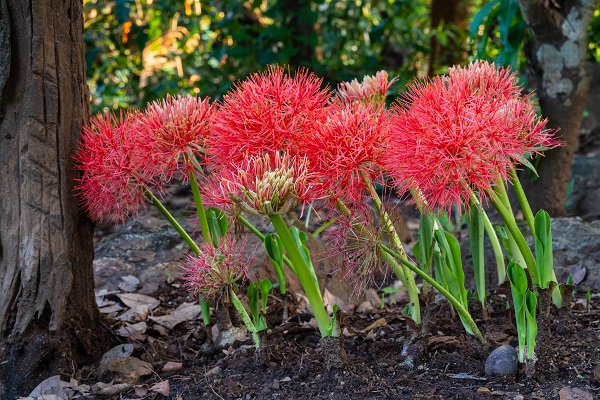
The "Blood Lily" is originally from Africa and Arabia and is part of the Amaryllis family. If planted in the ground, it works best in zones 9-11.
Blooms: Around late May or early June, a softball-sized flower will appear from each bulb for about 1-2 weeks. The fiery red blooms sit atop a naked stem with no foliage. The leaves will begin to appear and provide some lovely deep greeneryduring the hot summer months to take the plant into the fall. In the fall, the plant will produce red berries which may last for a couple of months.

Berries: Let's talk berries for a moment! The "Blood lily" will multiply for you two ways. First, the bulbs themselves will multiply. Then, you have these great little seed pods in the fall. Leave the pods alone until they start to shrivel. Then you can harvest them. If you want to plant in the ground, you can. Otherwise, simply place them in pots on top of damp potting soil. Press them lightly into the soil but do not cover them up. They will germinate and you have more plants!
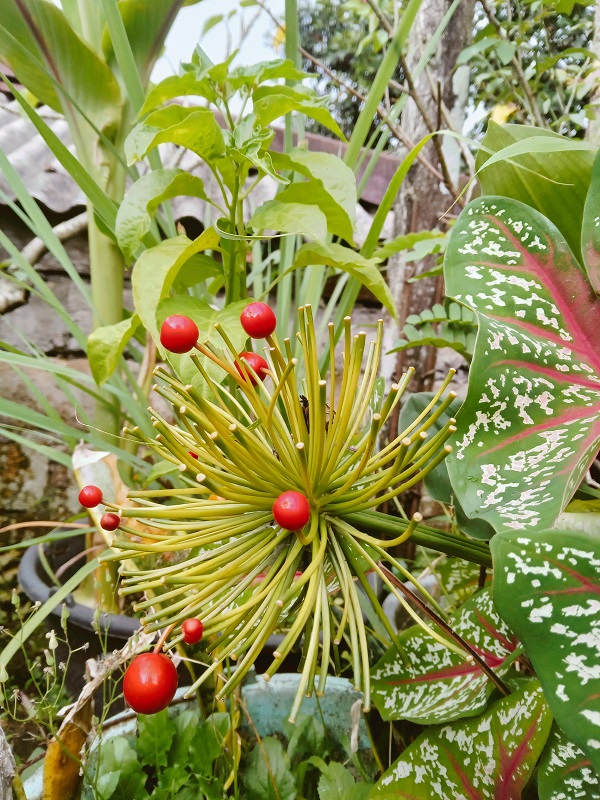
Temperature: This bulb needs the ground temperatures to be at least 60 degrees or higher. If you live north of zone 9, consider either planting in a pot and bringing it in during the winter or digging the bulbs and storing them.
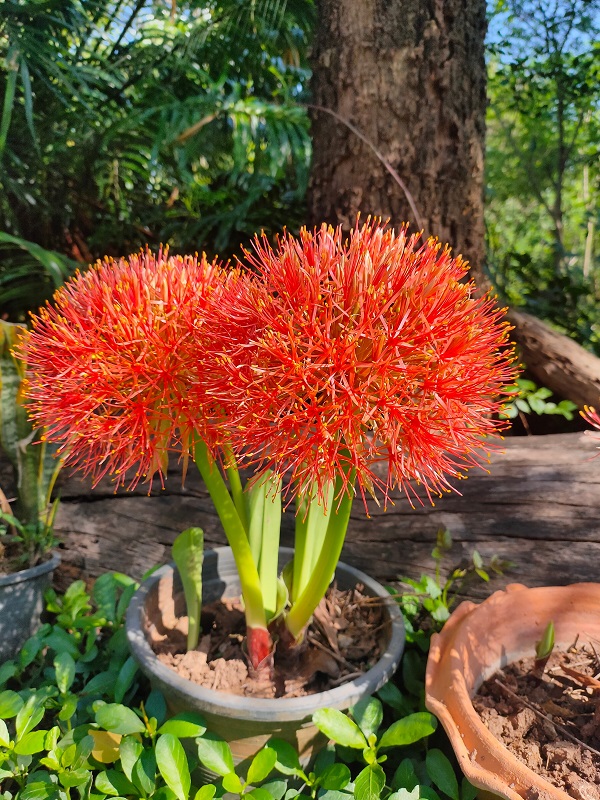
Pots: These bulbs work great when planted in pots. The 'Blood Lily" is certainly the THRILLER of a potted plant grouping because of the bloom's uniqueness, or you can simply put a couple in a pot and enjoy the show of red in the spring and fall. They produce better blooms when they are not disturbed very often. Consider getting a pot (or several) so that the bulbs can live happily without disturbance for several years. Consider placing the pots under or near trees during the summer(read below about light). Consider mixing potting soil with some sand to provide a little extra drainage which will benefit the bulb. During the winter, move the pot indoors and have it as a houseplant during the winter. Since it likes the humidity, mist the plants and keep it away from cold windows and drafts.
Plant: Plant the bulbs with just the top of the bulb visible at ground level. If you are planting this in the ground in the heat of the summer, consider adding a little mulch to protect it and water consistently to help it get established. The "Blood Lily" will get to about 2 feet tall and 12-16 inches wide so plant accordingly.
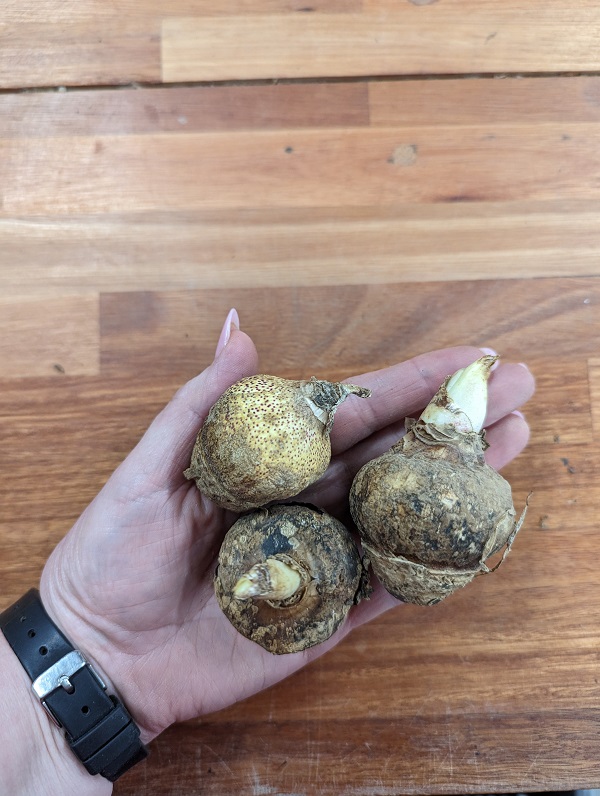
Water: If it is growing season and you plant them in the ground, they will perform best if they receive some good water at least once a week. Be sure not to overwater in the ground or in a pot. If you plant them in a pot, then make sure to water sparingly at first so as not to rot the bulb. Once the bulbs start to grow, though, increase the water so that they are well fed. Once the plant is ready to go dormant, water only enough to keep the bulbs from completely drying out (about 1/2 inch a week).
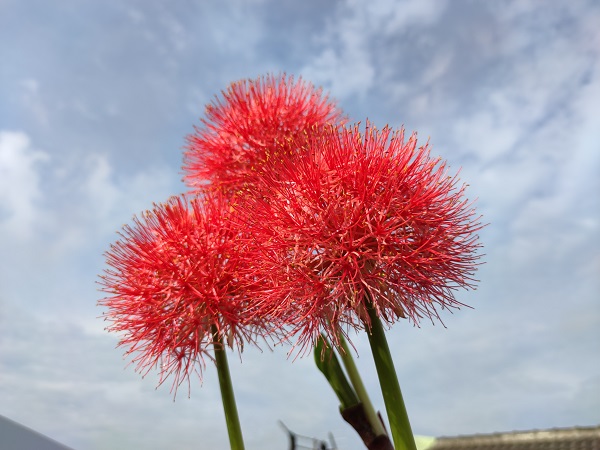
Soil: This plant does best if planted in well-drained soil.
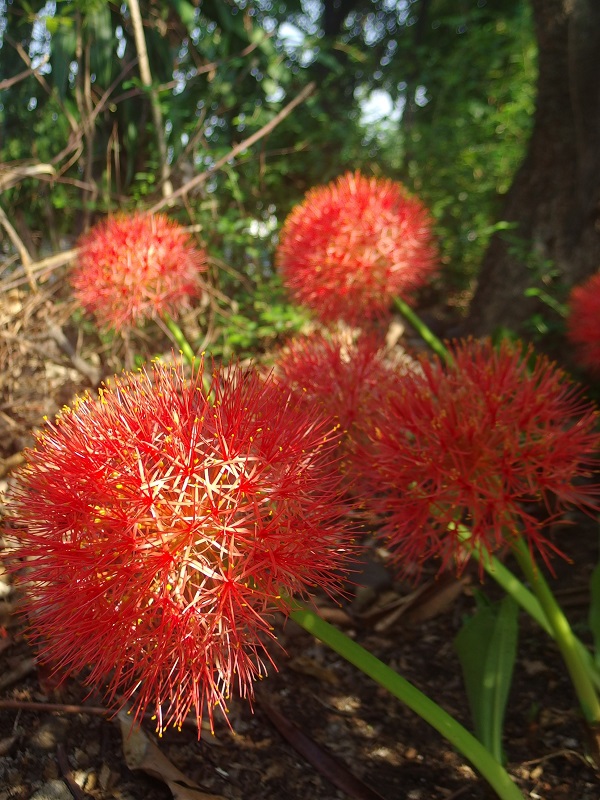
Light: Though these bulbs like the heat and humidity of the deep south, they actually do better in bright indirect light. They will perform well with summer morning sun but try to keep them out of direct afternoon sun. We put these in pots here at the office and loved them!
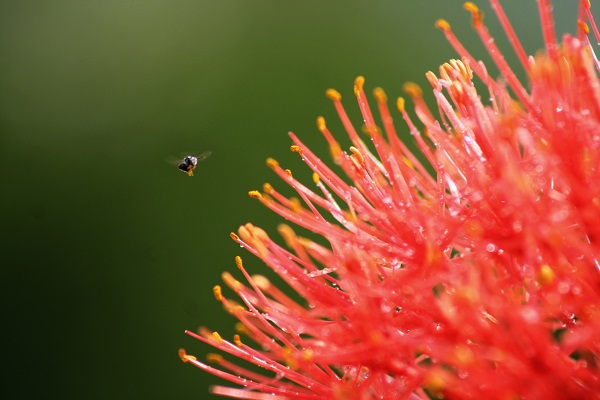
Animals: Butterflies, bees, and birds all enjoy these blooms.
Hey, Houston! Hey, Florida! Hey, Gulf Coast cities! This is the bulb for you. If you want a bulb that you can stick in the ground that doesn't require a lot of attention and produce some amazingly unique blooms at the beginning of summer, the "Blood Lily" is the answer. Now is a great time to go ahead and plant the Scadoxus multiflorus better known as the "Blood Lily" or "Blood Flower." This bulb grows well in zones 9-11, but that isn't going to keep those of us in zone 8 from planting some. We are just going to put them in pots to be able to protect them in the winter. Baseball to softball-size globes of fiery red appear on stems bringing bright color to your garden. They have beautiful dark green leaves for months, and in the fall, the stems produce bright berries which add a new splash of color to your garden.

The "Blood Lily" is originally from Africa and Arabia and is part of the Amaryllis family. If planted in the ground, it works best in zones 9-11.
Blooms: Around late May or early June, a softball-sized flower will appear from each bulb for about 1-2 weeks. The fiery red blooms sit atop a naked stem with no foliage. The leaves will begin to appear and provide some lovely deep greeneryduring the hot summer months to take the plant into the fall. In the fall, the plant will produce red berries which may last for a couple of months.

Berries: Let's talk berries for a moment! The "Blood lily" will multiply for you two ways. First, the bulbs themselves will multiply. Then, you have these great little seed pods in the fall. Leave the pods alone until they start to shrivel. Then you can harvest them. If you want to plant in the ground, you can. Otherwise, simply place them in pots on top of damp potting soil. Press them lightly into the soil but do not cover them up. They will germinate and you have more plants!

Temperature: This bulb needs the ground temperatures to be at least 60 degrees or higher. If you live north of zone 9, consider either planting in a pot and bringing it in during the winter or digging the bulbs and storing them.

Pots: These bulbs work great when planted in pots. The 'Blood Lily" is certainly the THRILLER of a potted plant grouping because of the bloom's uniqueness, or you can simply put a couple in a pot and enjoy the show of red in the spring and fall. They produce better blooms when they are not disturbed very often. Consider getting a pot (or several) so that the bulbs can live happily without disturbance for several years. Consider placing the pots under or near trees during the summer(read below about light). Consider mixing potting soil with some sand to provide a little extra drainage which will benefit the bulb. During the winter, move the pot indoors and have it as a houseplant during the winter. Since it likes the humidity, mist the plants and keep it away from cold windows and drafts.
Plant: Plant the bulbs with just the top of the bulb visible at ground level. If you are planting this in the ground in the heat of the summer, consider adding a little mulch to protect it and water consistently to help it get established. The "Blood Lily" will get to about 2 feet tall and 12-16 inches wide so plant accordingly.

Water: If it is growing season and you plant them in the ground, they will perform best if they receive some good water at least once a week. Be sure not to overwater in the ground or in a pot. If you plant them in a pot, then make sure to water sparingly at first so as not to rot the bulb. Once the bulbs start to grow, though, increase the water so that they are well fed. Once the plant is ready to go dormant, water only enough to keep the bulbs from completely drying out (about 1/2 inch a week).

Soil: This plant does best if planted in well-drained soil.

Light: Though these bulbs like the heat and humidity of the deep south, they actually do better in bright indirect light. They will perform well with summer morning sun but try to keep them out of direct afternoon sun. We put these in pots here at the office and loved them!

Animals: Butterflies, bees, and birds all enjoy these blooms.